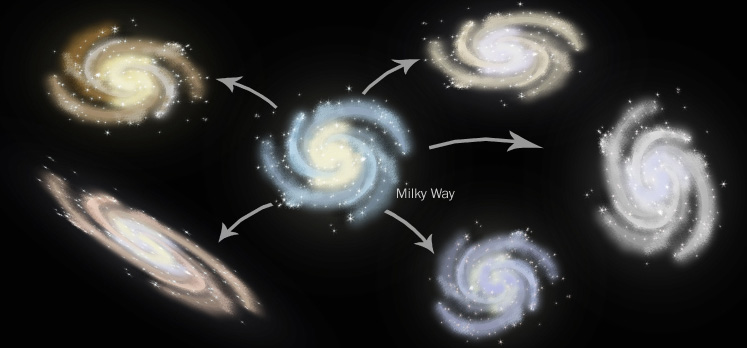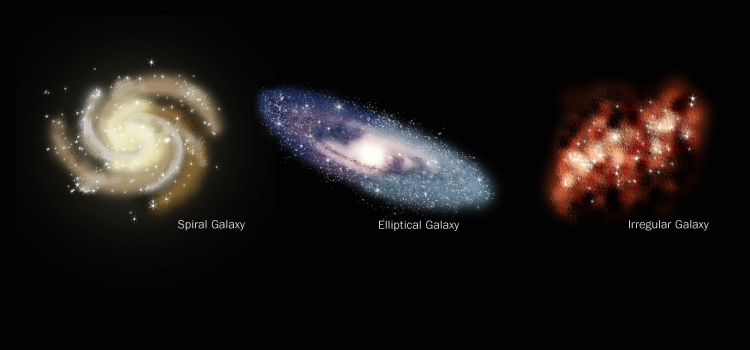 username@email.com
username@email.com
In this lesson, we’ll study the evidence that leads to the conclusion that the universe began with a colossal explosion called the Big Bang.
In the previous lesson we reviewed what science encompasses, how it works, and covered some of the diversity of its fields, spanning all human knowledge.
Also we learned that technology is the application of scientific knowledge to solve practical problems.
There is significant evidence that the universe was created in a Big Bang event. The generally accepted and most common scientific theory that explains the origin of our universe is that there was an explosion that took place about 14 billion years ago.
This explosion took place at the moment the universe began – starting from something about the size of a grain of sand and ending up as the universe as we now know it. There is significant evidence to support this theory. Scientists agree that the universe is currently expanding and thinning out. We know from the law of the conservation of mass, the total mass of the universe is constant, so all the matter of the universe must have been closer together at one time. This suggests that an explosion may have started the matter that became galaxies moving away from each other. From any place in the expansion, all other places appear to be moving away from each other at speeds proportional to their distances from the place of observation. The Big Bang theory also implies that the universe has a finite age, equal to the length of time since the big bang explosion.

Most galaxies appear to be moving away from the Milky Way galaxy, and in general particles appear to be moving away from each other as the universe continues to expand.
Astronomers can measure how fast the universe is expanding and the approximate distance to the furthest stars from parallax measurements. From this, they can calculate roughly how long the universe has been expanding to assess its age. Based on measurements of how fast distant galaxies are moving away from us and from measurements of the cosmic background radiation, astronomers estimate that the universe is about 13.7 billion years old.
Edwin Hubble, an American astronomer, made an important discovery in the 1920s that also helped give more credence to the Big Bang theory. Hubble studied the spectra of many galaxies moving away from each other and found a way to determine how fast our galaxy was moving, and in what direction it was moving relative to other galaxies. He discovered that with very few exceptions, all galaxies were moving away from each other simultaneously. Hubble noticed an important relationship between the speed of a galaxy and how far away it was from us. He used the Doppler shifts in the galaxies’ light to arrive at this relationship known as Hubble’s Law: The faster a galaxy is moving away from us, the farther away it is from us.
If the Big Bang theory is accurate, we would expect to find evidence that the universe is still spreading apart today just as it began doing billions of years ago. All observations from telescopes have been unable to refute this central tenet of cosmology and astronomy. We might also expect evidence of excess energy left over after the massive explosion. This, too, has been observed in every case where data are sufficient to make such a test.
What will happen to the universe in the distant future? One possibility is that the universe will continue to expand, as it is doing now, with its stars eventually using up all of their fuel and burning out like old light bulbs, making the universe a cold and dark place. Another possibility is that the universe will eventually stop expanding and start to implode. This would pull all the galaxies back together into a very dense black hole (like a recoiling rubber band) to result in a reverse of the Big Bang.
What does Hubble’s Law state?
The correct answer is C. The faster a galaxy is moving away from us, the farther away it is from us. Although some of the other examples may be true, none are the definition of Hubble’s Law.
Previously we covered the Big Bang theory and the origin of our universe. We also know that the universe contains an enormous number of galactic clusters, each full of billions of galaxies made up of stars, solar systems, planets, errant dust, rocks, and gas clouds held together by their own gravity. There are billions of galaxies in the universe with the largest galaxies containing trillions of stars. It is hard to comprehend just how massive the universe really is – it is probably beyond human understanding. But you get the idea.
There are several different configurations that galaxies can have. The most common are spiral, elliptical, and irregular.
Spiral galaxies are shaped like a flat disc or pinwheel (like our Milky Way galaxy), with a bulge in their center, and arms that spiral outward. Many bright young stars, dust, rocks, and gas make up the spiral arms. The youngest stars are found at the tips of the spiral arms. Very few new stars form in the denser central bulge. Many spiral galaxies have a barrel-shaped region of stars and gas that passes through the center of the galaxy, perpendicular to the main axis. These galaxies are called barred-spiral galaxies.
Elliptical galaxies are galaxies with a rounded or egg-shape to their central region, and without spiral arms or protrusions of any type. Although billions of stars are contained in elliptical galaxies, there is much less gas and dust between the individual stars. Because there is relatively little dust and gas (the stuff stars form from), there are fewer young stars in an elliptical galaxy than a spiral galaxy, for example.
Irregular galaxies are galaxies that have no regular spiral or elliptical shape. Irregular galaxies are typically much smaller than spiral or elliptical galaxies and have much more dust and gases, so they have a much higher concentration of bright, young stars.

Major types of galaxies: Spiral, Elliptical, and Irregular
There are also bright but very distant objects (ten billion years old or more) that look much like stars. “Quasi” means “something like” in Latin and hence, these objects were named quasi-stellar objects which became quasars.
Further study has revealed that quasars are very young, active galaxies with giant black holes and large amounts of gas around the center. As the gas heats up from the extreme friction in the dense gravity, the quasar heats up and shines brightly.
What is the configuration of an elliptical galaxy?
The correct answer is A. Although the other answers define configurations of other types of galaxies, elliptical galaxies are without spiral arms and have a rounded center region.
Our solar system is located in one of the arms of a spiral galaxy about halfway from the center of the galaxy to the outer edge. Some evidence now exists that our galaxy may actually be a barred-spiral galaxy. But the shape of the Milky Way galaxy depends on from where it is viewed. If you could view it from its side, it would look like a thin disk with a large bulge in its center. If viewed from the top or bottom you would see a typical spiral shape. The spiral shape cannot be seen from Earth because our solar-system’s vantage point is inside one of the galaxy’s spiral arms.
When we observe the Milky Way, we usually are looking toward the center of the galaxy, about 25,000 light-years away. We know its shape because we can study the center with X-rays, infrared radiation, and radio waves which are not blocked by the dust and gas as much as visible light.

Our Galaxy, the Milky Way and our approximate location within it.